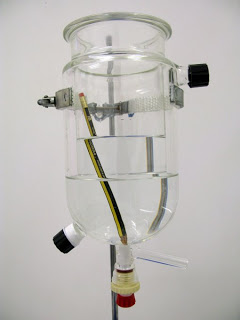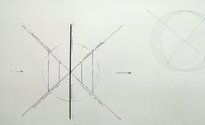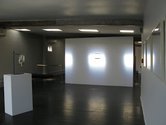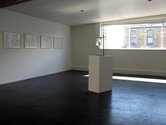John Hurrell – 18 March, 2009
His show plays with belief structures, implying that if you are sceptical of witchcraft (something he has occasionally used in his projects), then why not treat art assumptions based on what artists say, the same way. Artists are striving to achieve certain ends for their work via the use of artists' statements or writing, and these are like spells that need to be efficacious to succeed.
The last time Dane Mitchell had a show of work in Starkwhite he used the large downstairs space by the Karangahape Road entrance and was about to go to London. Now he is about to go to Berlin, but before he leaves he is taking advantage of part of the gallery’s storage facilities - in upstairs premises in a separate building out the back. As you can see from the above photographs, though it relies mostly on natural light, the presentation has been very successful: the space is not too small, but bigger than the stock display rooms in the main building.
The show has four pencil drawings, a sculpture in the centre of the space on a plinth, and a framed up interview on one wall. When I say sculpture and interview, I mean ‘sculpture’ and ‘interview’. The sculpture is really a footnote to the interview, the latter being a Mitchell variation of the famous Michael Craig-Martin ‘interview’ that accompanies ‘An Oak Tree’, a 1973 Craig-Martin artwork which is ostensibly a tumbler of water placed on a glass shelf. He insists - in a conversation with himself - that the filled glass is the outward appearance of an oak tree. In that conceptual sculpture, the label-interview (a statement more about the artist’s belief than any object) is the main ingredient. Same here with Mitchell.
His sculpture is a double-layered chemist’s flask with nozzles on the bottom. It is on a stand, and half filled with water. Into this Mitchell has immersed a pencil. Its image, as one would expect, is bent by the laws of refraction.
Not so, says Mitchell in his interview. “I have changed the direction of the light inside the vessel.” It’s not refraction he insists. He says that it is not an illusion.
So what is Mitchell telling us? Is he a wizard with supernatural powers? Does he think he is God? Can he achieve miracles, and that he himself controls the laws of nature? Or is he putting us on? Is he secretly laughing at the artworld’s propensity for delusion? That almost anything that is stated can get accepted as gospel.
If we imagine a number of invisible tubes leading from the nozzles at the bottom of the jar and going across the room to the wall of drawings - each tube containing ‘pencil juice’ - we can see a series of reflexive links that discuss their own process.
One drawing renders the experience of refraction, depicting how a line looks bent when immersed in liquid. Another is a diagram of light rays, presenting the law of physics that explains the phenomenon of refraction. It, very wittily, looks like a pencil tip. A third seems to abstractly refer to the process of evaporation of water from the unsealed flask, how the water level lowers, or - put another way - how the pencil rises. It seems to be about the oscillation of viewpoints.
The fourth diagram is about three worlds that invariably overlap: Reality, Unreality, and Illusion, and their relationship to those areas we accept as True on good faith. While many of Mitchell’s projects engage with mysticism and the spirit world as a source of invisible reality, they hint at parallel processes within art history and art institutions, and their apparent lack of ‘objective’ transparency. Like Craig-Martin, he teases out, by implication, a sort of nominalism where things denominated by the term ‘art’ share nothing except that fact. It is only a coating of declarative language that gives them a definition. No substance beneath that coating is necessary.
His show plays with belief structures, implying that if you are sceptical of witchcraft (something he has occasionally used in his projects), then why not treat art assumptions based on what artists say, the same way. Artists are striving to achieve certain ends for their work via the use of artists’ statements or writing, and these are like spells that need to be efficacious to succeed.
- John Hurrell





 Two Rooms presents a program of residencies and projects
Two Rooms presents a program of residencies and projects Advertising in this column
Advertising in this column



This Discussion has 0 comments.
Comment
Participate
Register to Participate.
Sign in
Sign in to an existing account.